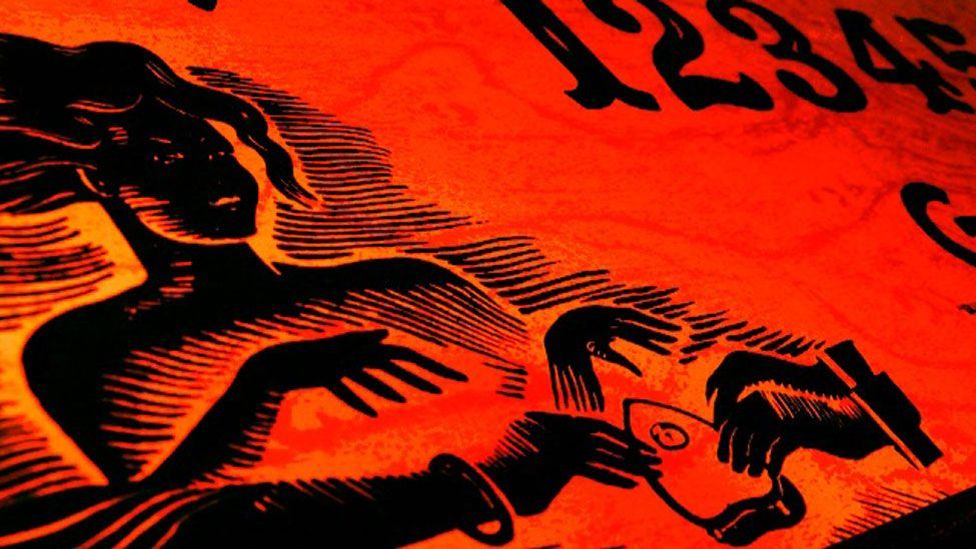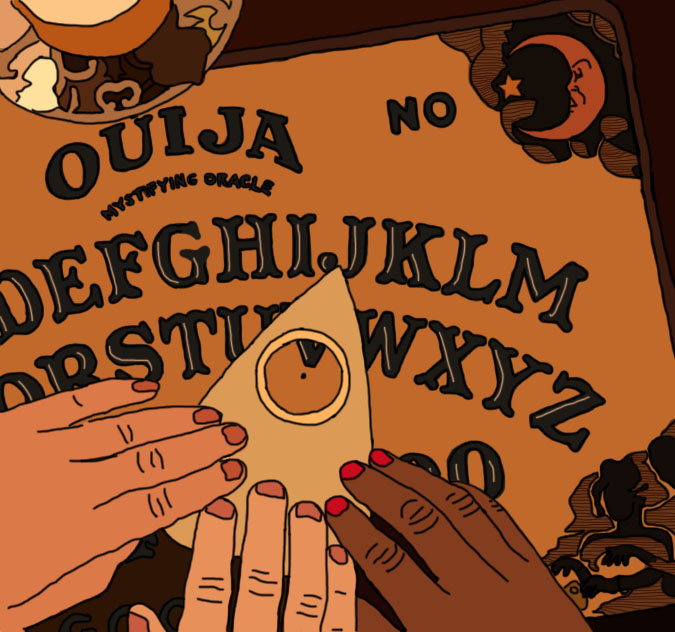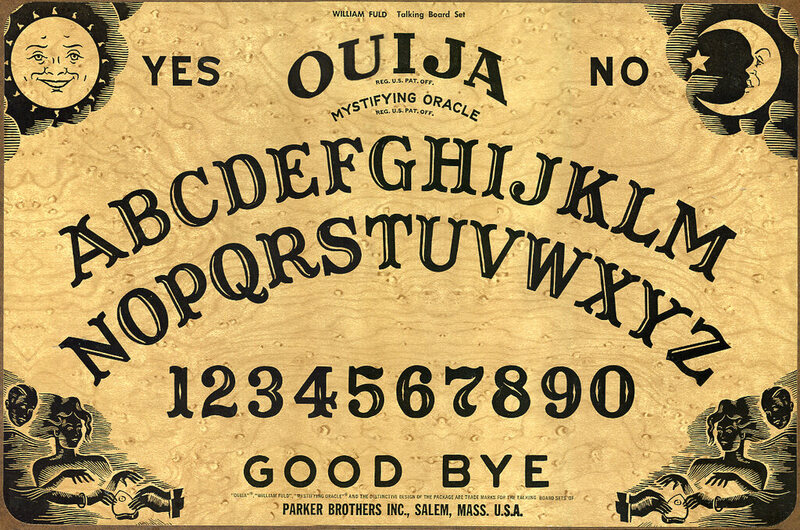In February 1891, the primary few promotions started showing in papers: “Ouija, the fantastic Talking Board,” boomed an urban center toy and novelty shop, describing a wizard device that answered queries “about the past, gift and future with marvelous accuracy” and secure “never-failing amusement and recreation for all the classes,” a link “between the familiar and unknown, the fabric and immaterial.” Another advertisement during a big apple newspaper declared it “interesting and mysterious” and testified, “as proven at government agency before it had been allowed. Price, $1.50.”
This mysterious talking board was essentially what’s oversubscribed in parlor game aisles today: A flat board with the letters of the alphabet panoplied in 2 semi-circles on top of the numbers zero through 9; the words “yes” and “no” within the upmost corners, “goodbye” at the bottom; in the middle of a “planchette,” a teardrop-shaped device, typically with alittle window in the body, wont to maneuver regarding the board. the thought was that two or additional individuals would sit round the board, place their finger recommendations on the board, create a question, and watch, dumbfounded, because the planchette enraptured from letter to letter, orthography out the answers ostensibly of its own accord. the largest distinction is in the materials; the board is currently typically cardboard, instead of wood, and therefore the board is plastic.
Also Read: WHAT IS INSTAGRAM AND HOW IT GROWN TO BE THE NO.1 APP SHARING PHOTO

although truth in advertising is tough to return by, particularly in merchandise from the nineteenth century, the Ouija board was “interesting and mysterious”; it truly had been “proven” to figure at the government agency before its patent was allowed to proceed; and today, even psychologists believe that it’s going to provide a link between the familiar and the unknown.
the $64000 history of the Ouija board is simply regarding as mysterious as however the “game” works. Ouija student Robert Murch has been researching the story of the board since 1992; once he started his research, he says, nobody very knew something regarding its origins, that stricken him as odd: “For such associate picture thing that strikes each worry and surprise in yankee culture, however can no one grasp wherever it came from?”
The gameboard board, in fact, came straight out of the yankee nineteenth century obsession with spiritualism, the idea that the dead are ready to communicate with the living. Spiritualism, which had been around for years in Europe, hit America exhausting in 1848 with the explosive prominence of the Fox sisters of upstate New York; the Foxes claimed to receive messages from spirits who rapped on the walls in associateswer to questions, recreating this deed of channeling in parlors across the state. power-assisted by the stories regarding the celebrity sisters and different spiritualists within the new national press, spiritualism reached uncountable adherents at its peak in the half of the nineteenth century. Spiritualism worked for Americans: it had been compatible with Christian dogma, that means one may hold a session on weekday night and don’t have any qualms about about to church succeeding day. it had been an acceptable, even wholesome activity to contact spirits at séances, through automatic writing, or table tipping parties, during which participants would place their hands on alittle table and watch it begin shake and rattle, whereas all of them declared that they weren’t moving it. The movement additionally offered solace in an era once the common life was under 50: girls died in childbirth; kids died of disease; and men died in war. Even Virgin Mary Todd Lincoln, partner of the venerable president, conducted séances within the White House when their 11-year-old son died of a fever in 1862; throughout the Civil War, spiritualism gained adherents in droves, individuals eager to connect with precious ones who’d gone away to war and ne’er come back home.
the manufacturers of the primary talking board asked the board what they must decision it; the name “Ouija” came through and, once they asked what that meant, the board replied, “Good luck.” Robert Murch

“Communicating with the dead was common, it wasn’t seen as outre or weird,” explains Murch. “It’s exhausting to imagine that now, we glance at that and think, ‘Why are you gap the gates of hell?’”
however opening the gates of hell wasn’t on anyone’s mind once they started the Kennard Novelty Company, the primary producers of the gameboard board; in fact, they were principally wanting to open yankees’ wallets.
As spiritualism had fully grown in American culture, therefore too did frustration with however long it took to urge any meaty message out of the spirits, says Brandon Hodge, Spiritualism historian. career out the alphabet and awaiting a knock at the proper letter, for example, was deeply boring. when all, speedy communication with respiration humans at so much distances was a possibility—the telegraph had been around for decades—why shouldn’t spirits be as easy to reach? individuals were desperate for ways of communication that may be quicker—and whereas many entrepreneurs completed that, it had been the Kennard Novelty Company that basically nailed it.
In 1886, the fledgling Associated Press rumored on a replacement development seizing the spiritualists’ camps in Ohio, the talking board; it was, for all intents and purposes, a gameboard board, with letters, numbers and a planchette-like device to purpose to them. The article went so much and wide, however it was Charles Kennard of Baltimore, Maryland who acted on it. In 1890, he force along a gaggle of 4 different investors—including prophet Bond, a neighborhood attorney, and Col. Washington Bowie, a surveyor—to begin the Kennard Novelty Company to solely create and market these new talking boards. None of the lads were spiritualists, really, however they were all of them keen businessmen and therefore they’d known a niche.
however they didn’t have the Ouija board yet—the Kennard talking board lacked a name. Contrary to common belief, “Ouija” isn’t a mix of the French for “yes,” oui, and the German ja. Murch says, supported his research, it had been Bond’s sister-in-law, Helen Peters (who was, Bond said, a “strong medium”), who supplied the currently instantly recognizable handle. Sitting round the table, they asked the board what they must decision it; the name “Ouija” came through and, once they asked what that meant, the board replied, “Good luck.” Eerie and cryptic—but for the {very fact|the actual fact} that Peters acknowledged that she was carrying a case bearing the image of a woman, the name “Ouija” on top of her head. That’s the story that emerged from the gameboard founders’ letters; it’s very doable that the girl within the locket was known author and common women’s rights activist Ouida, whom Peters admired, which “Ouija” was simply a misreading of that.
The board’s instant and now, over one hundred twenty years later, prolonged success showed that it had broached into a weird place in yankee culture. it had been marketed as each mystical oracle and as family entertainment, fun with part of other-worldly excitement. This meant that it wasn’t solely religiousists who bought the board; in fact, the those that dislikable the Ouija board the foremost attended be spirit mediums, as they’d simply found their job as spiritual middleman cut out. The Ouija board appealed to individuals from across a good spectrum of ages, professions, and education—mostly, Murch claims, as a result of the Ouija board offered a fun manner for individuals to believe one thing. “People wish to believe. the requirement to believe that something else is out there’s powerful,” he says. “This thing is one in every of those things that enables them to specific that belief.”
It’s quite logical then the board would realize its greatest quality in unsure times, once people stick to belief and appearance for answers from almost about anywhere, particularly cheap, DIY oracles. The 1910s and ’20s, with the devastations of war I and therefore the frenzied years of the Jazz Age and prohibition, witnessed a surge in Ouija popularity. it had been therefore traditional that in might 1920, Norman Rockwell, creative person of happy twentieth century domesticity, portrayed a person and a woman, Ouija board on their knees, communing with the on the far side on the quilt of the weekday Evening Post. throughout the good Depression, the Fuld Company opened new factories to satisfy demand for the boards; over 5 months in 1944, one big apple retail store oversubscribed 50,000 of them. In 1967, the year when Parker Brothers bought the sport from the Fuld Company, two million boards were sold, outselling Monopoly; that same year saw additional yankee troops in Vietnam, the counter-culture Summer of affection in San Francisco, and race riots in Newark, Detroit, Minneapolis and Milwaukee.
Strange gameboard tales additionally created frequent, titillating appearances in yankee newspapers. In 1920, national wire services rumored that would-be crime solvers were turning to their Ouija boards for clues within the mysterious murder of a replacement House of York town gambler, Joseph Burton Elwell, a lot of to the frustration of the police. In 1921, The big apple Times reported that a Chicago lady being sent to a hospital tried to elucidate to doctors that she wasn’t suffering from mania, however that Ouija spirits had told her to depart her mother’s body within the lounge for fifteen days before burial her in the backyard. In 1930, newspaper readers excited to accounts of 2 girls in Buffalo, big apple, who’d dead another woman, purportedly on the encouragement of Ouija board messages. In 1941, a 23-year-old petrol station attendant from New Jersey told The New House of York Times that he joined the military as a result of the Ouija board told him to. In 1958, a Connecticut court set to not honor the “Ouija board will” of Mrs. Helen Dow Peck, who left solely $1,000 to 2 former servants associated an insane $152,000 to Mr. John wind Forbes—a lucky, however bodiless spirit who’d contacted her via the Ouija board.
Ouija boards even offered literary inspiration: In 1916, Mrs. Pearl Curran created headlines once she began writing poems and stories that she claimed were dictated, via Ouija board, by the spirit of a seventeenth century Englishwoman referred to as Patience Worth. the subsequent year, Curran’s friend, Emily Grant Hutchings, claimed that her book, Japanese Herron, was communicated via Ouija board by the late prophet Clemens, higher referred to as Mark Twain. Curran earned important success, Hutchings less, however neither of them achieved the heights that Joseph Pulitzer Prize-winning writer James Merrill did: In 1982, his epic Ouija-inspired and set poem, The dynamic light-weight at Sandover, won the National Book Critics Circle Award. (Merrill, for his part, in public silent that the Ouija board acted additional as a scientific instrument for his own poetic thoughts, instead of as hotline to the spirits. In 1979, when he wrote Mirabelle: Books of Number, another Ouija creation, he told The big apple Review of Books, “If the spirits aren’t external, however astonishing the mediums become!”)
Ouija existed on the boundary of yankee culture, perennially popular, mysterious, attention-grabbing and usually, expulsion the few cases of supposed Ouija-inspired murders, non-threatening. That is, till 1973.
therein year, The Exorcist frightened the pants off individuals in theaters, with all that pea soup and head-spinning and purportedly supported a real story business; and therefore the implication that 12-year-old Regan was possessed by a demon when fiddling with a Ouija board by herself modified however people saw the board. “It’s reasonably like Psycho—no one was frightened of showers until that scene… It’s a transparent line,” says Murch, explaining that before The Exorcist, film and television depictions of the Ouija board were typically jokey, hokey, and silly—“I Love Lucy,” for example, featured a 1951 episode during which Lucy and Ethel host a session victimization the Ouija board. “But for a minimum of ten years afterwards, it’s no joke… [The Exorcist] truly modified the material of pop culture.”
virtually overnight, Ouija became a tool of the devil and, for that reason, a tool of horror writers and moviemakers—it began taking drugs in scarey movies, usually gap the door to evil spirits resolute on cacophonic apart co-eds. Outside of the theatre, the subsequent years saw the Ouija board denounced by spiritual teams as Satan’s most well-liked methodology of communication; in 2001 in Alamogordo, New Mexico, it had been being burned on bonfires at the side of copies of Harry Potter and Disney’s Snow White. Christian religious groups still stay cautious of the board, citing scripture denouncing communication with spirits through mediums—Catholic.com calls the Ouija board “far from harmless” and as recently as 2011, 700 Club host Pat Oscar Palmer Robertson declared that demons will reach us through the board. Even among the paranormal community, Ouija boards enjoyed a dodgy reputation—Murch says that once he initial began speaking at paranormal conventions, he was told to depart his antique boards reception as a result of they frightened individuals too much. Parker Brothers and later, Hasbro, when they nonheritable Parker Brothers in one991, still oversubscribed many thousands of them, however the explanations why people were shopping for them had modified significantly: gameboard boards were spooky instead of spiritual, with a definite shudder of danger.
In recent years, Ouija is common however again, driven partially by economic uncertainty and therefore the board’s utility as a plot device. The vastly popular Paranormal Activity 1 and a couple of each featured a Ouija board; it’s popped up in episodes of “Breaking Bad,” “Castle,” “Rizzoli & Isles” associated multiple paranormal reality TV programs; Hot Topic, mall favorite of Gothy teens, sells a collection of Ouija board undergarment and underwear; and for those want to commune with the on the far side whereas on the go, there’s an app (or 20) for that. This year, Hasbro discharged a additional “mystical” version of the sport, substitution its recent glow-in-the-dark version; for purists, Hasbro additionally authorised the rights to create a “classic” version to a different company. In 2012, rumors that Universal was in talks to make a movie supported the game abounded, though Hasbro refused to discuss that or anything for this story.
however the $64000 question, the one everybody desires to know, is however do gameboard boards work?
Ouija boards are not, scientists say, powered by spirits or perhaps demons. unsatisfactory but additionally probably useful—because they’re powered by us, even once we protest that we’re not doing it, we swear. Ouija boards work on a principle familiar to those learning the mind for over one hundred sixty years: the ideometer effect. In 1852, Dr. and biologist William Benjamin Carpenter printed a report for the Royal establishment of nice Britain, examining these automatic muscular movements that crop up while not the acutely aware can or volition of the individual (think crying in reaction to a tragic film, for example). virtually immediately, different researchers saw applications of the ideometer impact within the common spiritualist pastimes. In 1853, chemist and scientist archangel Faraday, intrigued by table-turning, conducted a series of experiments that proven to him (though to not most spiritualists) that the table’s motion was thanks to the ideomotor actions of the participants.
The effect is extremely convincing. As Dr. Chris French, prof of scientific discipline and anomalistic psychology at Goldsmiths, University of London, explains, “It will generate a really robust impression that the movement is being caused by some outside agency, however it’s not.” different devices, cherish divination rods, or additional recently, the faux bomb detection kits that deceived legion international governments and armed services, work on identical principle of non-conscious movement. “The factor regarding of these mechanisms we’re talking about, dowsing rods, Oujia boards, pendulums, these tiny tables, they’re all devices whereby a quite small muscular movement can cause quite a massive effect,” he says. Planchettes, in particular, are well-suited for his or her task—many wont to be created of a lightweight wood board and fitted with tiny casters to assist them move additional swimmingly and freely; now, they’re typically plastic and have felt feet, that additionally help it slide over the board easily.
“You do far better with the gameboard on queries that you just really don’t suppose you grasp, however truly one thing within you will know and therefore the Ouija will assist you answer on top of chance,” says Fels.
UBC’s experiments show that the Ouija might be a really useful gizmo in strictly work non-conscious thought processes. “Now that we’ve got some hypotheses in terms of what’s happening here, accessing information and psychological feature talents that you just don’t have acutely aware awareness of, [the gameboard board] would be an instrument to truly get at that,” Fels explains. “Now we will begin victimization it to raise different forms of queries.”
Those types of questions embrace what proportion and what the non-conscious mind knows, how briskly it can learn, however it remembers, even how it amuses itself, if it does. This disclose even additional avenues of exploration—for example, if there are 2 or more systems of data processes, that system is more compact by neurodegenerative diseases, cherish Alzheimer’s? If it impacted the non-conscious earlier, Rensink hypothesizes, indications of the ill health may show up in gameboard manipulation, presumably even before being detected in acutely aware thought.
For the moment, the researchers are acting on protection down their findings during a second study and firming up protocol around victimization the Ouija as a tool. However, they’re running up against a problem—funding. “The classic funding agencies don’t wish to be related to this, it appears a touch too out there,” aforementioned Rensink. All the work they’ve done so far has been volunteer, with Rensink himself paying for a few of the experiment’s costs. To get around this issue, they’re wanting to crowd-funding to create up the gap.
although they don’t succeed, the UBC team has managed to make sensible on one in every of the claims of the first gameboard advertisements: The board will provide a link between the familiar and therefore the unknown. simply not the unknown that everybody needed to believe it was.






